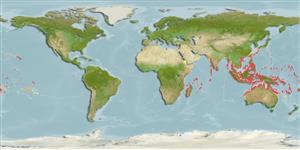Common names from other countries
Environment: milieu / climate zone / depth range / distribution range
Ecología
marino asociado a arrecife; no migratorio; rango de profundidad 1 - 25 m (Ref. 9710). Tropical; 35°N - 30°S, 30°E - 125°W
Indo-Pacific: East Africa to the Samoan and Phoenix Islands, north to southern Japan, south to New Caledonia; throughout Micronesia.
Tamaño / Peso / Age
Maturity: Lm ? range ? - ? cm
Max length : 15.0 cm TL macho / no sexado; (Ref. 9710); edad máxima reportada: 13 años (Ref. 3420)
Espinas dorsales (total) : 15; Radios blandos dorsales (total) : 15 - 17; Espinas anales: 3; Radios blandos anales: 17 - 18.
Inhabits lagoon, channel, or protected seaward reef slopes, drop offs, coral and rubble areas (Ref. 1602). Usually in pairs or in small groups. Feeds on algae, small crustaceans and worms. Darts from one hiding place to the next. Commonly exported through the aquarium trade (Ref. 48391).
Life cycle and mating behavior
Maturities | Reproducción | Spawnings | Egg(s) | Fecundities | Larva
Pelagic spawner. Sex reversal is completed in 18-20 days (Ref. 34185, 34248). Also Ref. 103751.
Steene, R.C., 1978. Butterfly and angelfishes of the world. A.H. & A.W. Reed Pty Ltd., Australia. vol. 1. 144 p. (Ref. 4859)
IUCN Red List Status (Ref. 130435)
CITES (Ref. 128078)
Not Evaluated
Threat to humans
Harmless
Human uses
Pesquerías: pesquerías de subsistencia; Acuario: Comercial
Herramientas
Special reports
Download XML
Fuentes de Internet
Estimates based on models
Preferred temperature (Ref.
115969): 25 - 29.3, mean 28.5 (based on 3298 cells).
Phylogenetic diversity index (Ref.
82804): PD
50 = 0.5000 [Uniqueness, from 0.5 = low to 2.0 = high].
Bayesian length-weight: a=0.03090 (0.01359 - 0.07026), b=2.89 (2.70 - 3.08), in cm Total Length, based on LWR estimates for this (Sub)family-body shape (Ref.
93245).
Nivel trófico (Ref.
69278): 3.0 ±0.34 se; based on food items.
Resiliencia (Ref.
120179): Bajo, población duplicada en un tiempo mínimo de 4.5-14 años (tmax=13).
Fishing Vulnerability (Ref.
59153): Low vulnerability (11 of 100).
